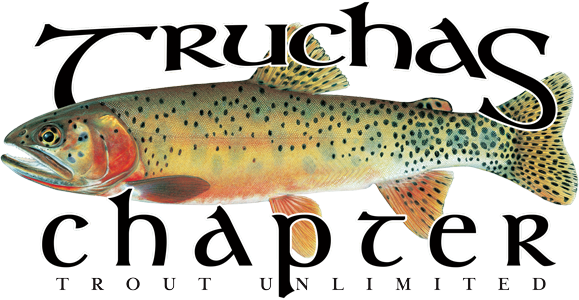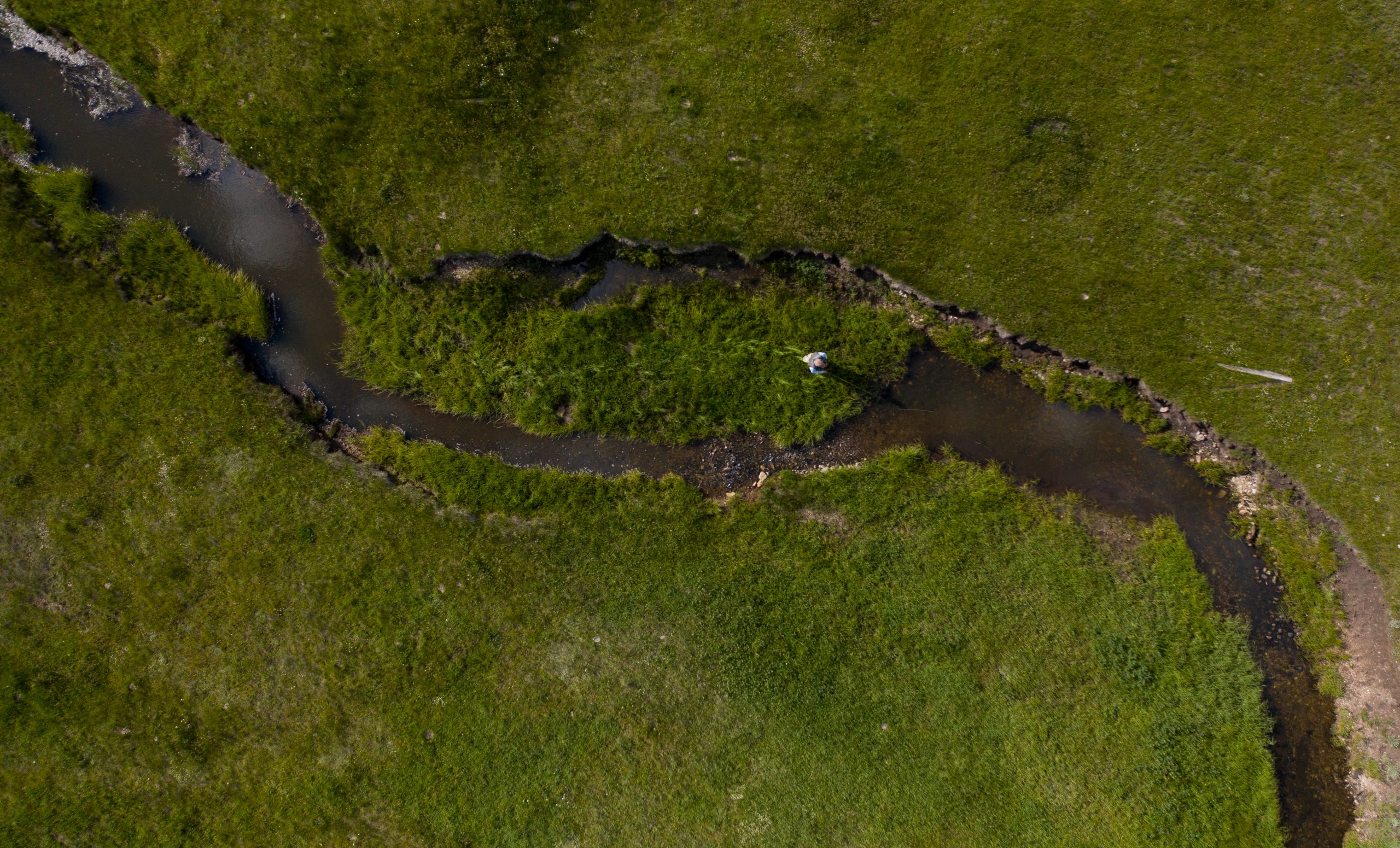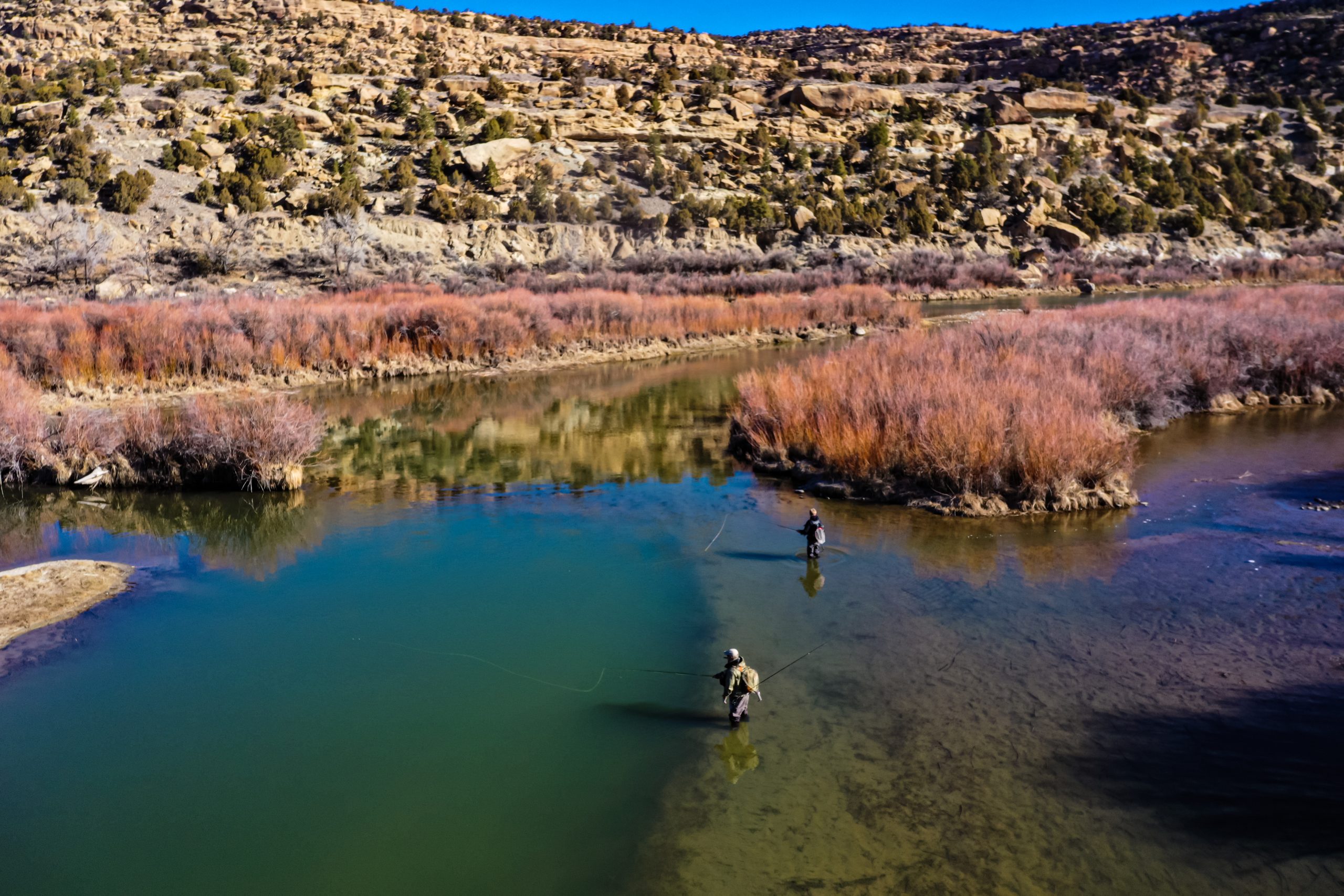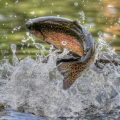This is one of the most common questions we hear at Trout Unlimited events – either from experienced fly fishermen new to this state or beginners who have mastered the basics of casting and knots and want to know where to catch fish. You can always hire a local guide – they will hone your techniques as well as put you on fish and give you a feel for how fish behave in this high desert environment. But often these trips are held on private water, where the fishing pressure is less and you cannot routinely go back on your own. If you are like me, you may want to fish 5-10 times a month during the prime season – meaning you better learn some public waters or win the lottery.
Although I was a very experienced Midwestern angler (mostly walleye and pike on lakes), I was new to fly fishing and trout when I retired to New Mexico 7 years ago. My wife and I took a community college class on fly fishing, taught in conjunction with The Reel Life, which consisted of 5 sessions of lessons with guides on the water. This was a great cost-effective introduction and I’d highly recommend it for beginners. After that we knew three places we could fish, but we were ready to expand our list of places to fish. After spending much time on research, in 3-5 years I have now developed a list of over 50 places to go within day trip distance (1-2 hours) from Santa Fe. Some of this may seem obvious to those who grew up in NM or have a lot of experience with fly fishing, but I hope with the tips below that those new to the state or the sport can start enjoying the diverse opportunities to catch trout sooner. One thing I have learned, is that because trout require cool clean water, these spots are among the prettiest locations in the state – even if they’re not biting that day!
The Big Three Rivers
Any list of fishing locations in northern New Mexico starts with the Big 3 – the Rio Grande, Pecos River, and Rio Chama. These are the largest rivers in the area and the most popular, and fairly accessible via road. The Rio Grande starts in Colorado and is fishable from the state line down to about Santa Fe. North of Espanola there are several pullouts on the road to Taos that can be very productive – from County Line to Quartzite to various camping and picnic areas in Pilar up to the Taos Junction Bridge. North of that gets you into the Rio Grande Gorge, where there can be larger rainbows and brown trout but you need to plan access down the steep gorge. You can hike in above the Taos Junction bridge or access the river at the John Dunn bridge or in the Rio Grande del Norte National Monument.
Primary access to the Rio Chama tailwaters is below Abiqui Dam (in the fall-winter, when the dam is not releasing large amounts of water for agriculture) or below El Vado Dam (in the summer, daily access fee at Cooper’s Ranch). Freestone fishing is possible further north near the town of Chama.
The Pecos River consists of miles of water accessible from the highway north of the town of Pecos, much of it public with some private areas dispersed. Popular public access points include Dalton picnic area, Windy bridge picnic area, Terrero camping area, the Willow Creek – Mora confluence area, and near the road’s end above Cowles. There are a few hike-in locations when the river diverts further from the road that have special fishing regulations but can get you away from the crowds. This river can get busy on weekends, and some of it is now Pecos Canyon State Park and requires day fees or an annual pass. There are numerous macroinvertebrate hatches on this pristine river, and if you catch a stonefly or caddis hatch at the right time with the right flies, you can see a lot of fish. This section of the Pecos is stocked regularly with triploid rainbow trout during the spring-fall season, but this high altitude canyon river is frozen in the winter.
Tributaries and Small Streams
Each of these primary river systems is fed by numerous smaller streams which can hold excellent trout populations for those willing and able to do a little hiking to enjoy some solitude. As an added bonus, the higher you get up into the mountains, you may be able to access populations of native Rio Grande Cutthroat trout, which have been nearly eliminated from the lower reaches by competition from introduced rainbow and brown trout. Many of these streams are 5-10 feet wide and only 6-12 inches deep, so are easy to navigate without waders in the warmer months.
The Rio Grande drains much of northern NM and the Sangre de Cristo range. The Red River joins the Rio Grande southwest of Questa, and holds a good population of rainbow and brown trout, plus some cutbow hybrids that come up the river seasonally. It can be fished below the state fish hatchery or along the roads leading to the town of Red River. Further south, the Embudo and the Rio Pueblo empty into the Rio Grande from the east and these smaller streams provide good fishing opportunities. Rio Santa Barbara, above the campground, has a very healthy population of brown trout that will hit dry flies in the summer months.
The lower Jemez River, below Battleship Rock, is stocked in winter months only, as the water is too warm to hold a reliable population of trout in the summer. The many streams flowing into the Jemez drainage provide ample summer fishing spots, some of which are supplemented by stocked rainbow trout as well. Meadow stream fishing, where your casts are as likely to land in grass as in the stream, are available in the Cebolla (north of Fenton Lake), the San Antonio (above the hot springs area), and the Valles Caldera (check with the rangers for special fishing regulations). Above the Gilman tunnels on Highway 376, the Guadalupe River has some great brown trout fishing in its remote canyons. Further upstream it is joined by the Rio de las Vacas, which holds both rainbow and brown trout.
There are many good fishing streams that flow into the Pecos River, as these drain the mountain range, where there is more precipitation and natural springs. The Mora River enters the Pecos from the east and has miles of fishing opportunities from several entry points. Holy Ghost Creek enters from the west, and is sometimes stocked with rainbows in addition to the brown trout that inhabit it year-round. Further north, Panchuela Creek flows into the Pecos just above the Cowles Ponds and is accessible for a day parking fee at its campground. Jack’s Creek crosses the road to the campground of the same name, and is being managed as a Rio Grande cutthroat stream by use of a barrier that keeps non-native trout from swimming upstream. These creeks can have some excellent fishing at the right time of year, but be forewarned, are less accessible due to strong brush cover.
Rio Vallecitos flows towards the Rio Chama, although in times of low water it dissipates before reaching the main river. Public access points above Ojo Caliente provide good brown trout fishing, with the best fishing being the parts furthest from road access that require longer hikes.
Lake Fishing
Trout can also be caught from lakeshores in New Mexico, and are more commonly visited by those using bait fishing techniques. Some of the lakes are stocked in summer – Monastery Lake (near Pecos), Santa Cruz (east of Espanola) and Fenton Lake (west of La Cueva and Jemez Springs). Other popular spots that are a longer drive from Santa Fe include Eagle Nest (north of Angel Fire), the Canjilon lakes (north of Abiqui), and Hopewell Lake (west of Tres Piedras, holds some brook trout) and El Vado Lake (near Tierra Amarillo). For those who are willing to hike backcountry, there are numerous lakes in the Pecos Wilderness Area that hold trout, including Rio Grande cutthroats.
Travel in New Mexico
There are other good fishing spots that are longer drives, and more amenable for combining with a camping trip or an overnight stay at a local hotel. The San Juan is arguably the most famous river in the state for fly fishing and holds some large fish. It is recommended that you use a guide for your first forays on this water, as the fishing can be quite technical and the large fish are typically caught with smaller flies. Rio Costilla is being successfully developed as a Rio Grande cutthroat river, and as such is closed to fishing until after July 1, when the spring spawning is done. These are plentiful campsites close to the river, and the stretches below the fish barrier are stocked with rainbows seasonally. The Cimarron River, which flows out of Eagle Nest Lake, is buffered from spring runoff and is a good place to fish in the spring when other rivers are too fast. It flows east towards Cimarron, and has a sustainable population of brown trout plus stocked rainbow trout. If you want to complete the New Mexico trout challenge (all 5 species), you will need to try your hand at fishing near Sliver City in the Gila River area for Gila trout. Willow Creek (near the Catwalk attraction), Mineral Creek, and Mogollon Creek also hold Gila trout and there is some limited stocking.
Resources
I am still adding new spots to my list every year – sometimes by simply looking at a map and seeing a new creek and giving it a try. For detailed maps showing small streams and access roads, try Delorme’s Atlas and Gazeteer or Benchmark Maps’ New Mexico Road and Recreation Atlas. Some of my favorite spots came about by talking with other fly fishermen that I met in the wild – the more remote the spot, the less fishing pressure, and the greater the chance they don’t mind sharing their tips with you. Socializing with fly fishing groups, such as the Ales and Tales events held by Truchas Chapter of Trout Unlimited quarterly, gives you a great chance to share locations with other anglers. Watch the stocking reports and fishing reports on the NM Dept of Game &Fish website and consider trying the spots that you have not been to yet. There are several good books on fly fishing in New Mexico that are good resources. Although the information can be dated as to species and road access points, the streams are still there and most are still viable spots. Whether you choose to buy the books or check them out at the public library, I recommend Martin (Fly Fishing in Northern New Mexico), Beacham (Flyfisher’s Guide to New Mexico) and Shewnack/Frangos (49 Trout Streams of New Mexico).
Final Thoughts
The real question is not where can you fish, there are many choices once you learn the techniques above, it’s where should you fish on a given day. First, it is all seasonal – the best summer spots may be frozen over in winter, and the best winter spots may be too warm in the summer. Many places are not fishable during the snow runoff in May, or in the 24 hours after a major monsoon rain in the area. Most rivers and streams have an optimum flow (cfs = cubic feet per second), and the United States Geological Survey has gauges in most of the larger rivers and streams that you can access on-line. It only takes a few 90 minute drives to access a chocolate brown river with waves or a near empty warm stream before you realize you should save time by making sure the conditions are amenable to fishing. The right bug hatch (which can vary by weather conditions) can turn a slow spot into an action-packed spot. As a former scientific researcher and current fishing nerd, I have a spreadsheet with notes on all the spots I fish, indicating the species available, optimum flow, best times of the year to fish, whether dry flies or nymphs were successful, when the hatches occur, etc. This is just another way to say, the more experience you get on the water, as long as you learn the lessons it teaches you, the better you will get at catching trout in NM. I have miles to go in terms of technique and learning to match flies with local macroinvertebrates, but even as an amateur with only a few years of fly fishing experience, I still catch nearly a thousand trout per year (keeping only 2-3 for the grill and gently releasing the rest). If you eat more fish than I do, please consider keeping mostly the sterile stocked rainbows or invasive brown trout from highly populated streams – the native trout in NM (Gila and Rio Grande Cutthroat) don’t taste any different and could use your help in maintaining viable populations.




Welcome to fly fishing in New Mexico – and lots of luck finding your own favorite spots. We’re glad you are here and hope you will consider joining a conservation group to preserve this gem for the future.
— Mike Jozwiakowski, Amateur Fly Fisherman



